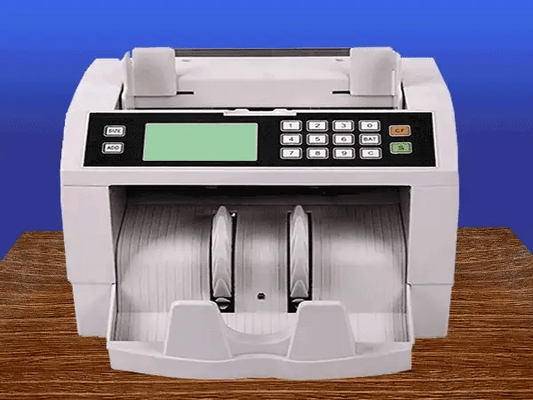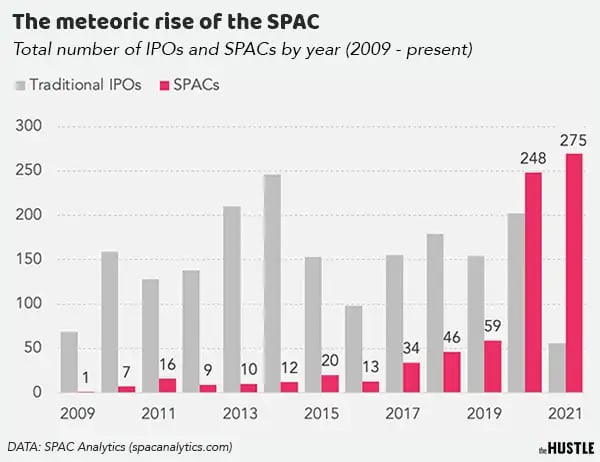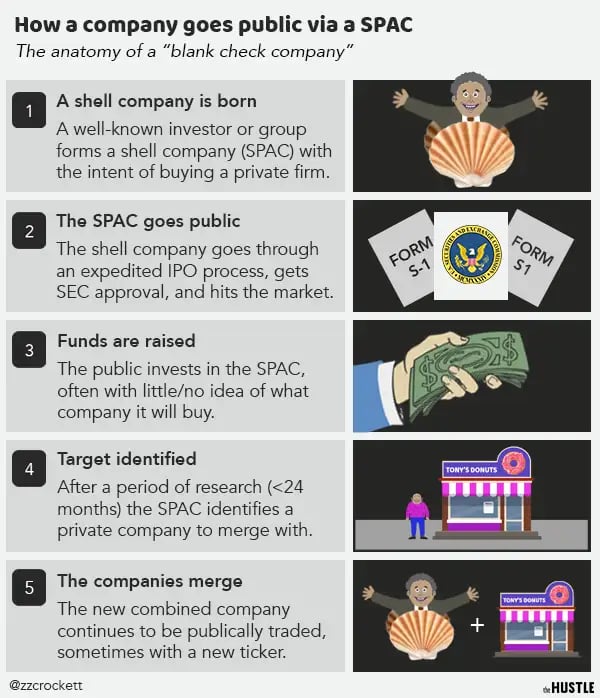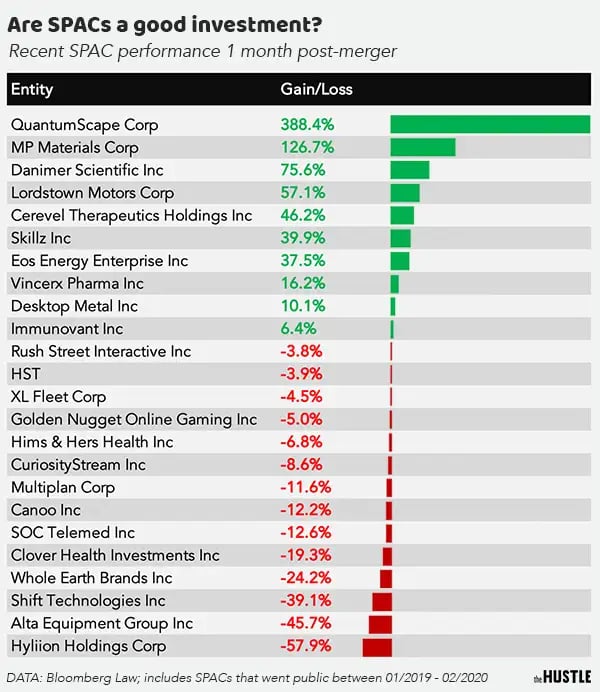TL;DR: A SPAC is a publicly traded shell company set up specifically to merge with, and take public, a private company. In the past year, we’ve seen a massive spike in SPACs as an alternative to traditional IPOs, but questions remain about whether they’re a good investment for the public.

What do these 5 people have in common?
- Shaquille O’Neal (7’1” NBA legend)
- Scott Kelly (former astronaut)
- Paul Ryan (ex-congressman)
- Serena Williams (one of history’s greatest tennis stars)
- Bill Ackman (hedge fund billionaire)
Answer: They all have a hand in SPACs (special purpose acquisition companies), one of the hottest financial trends on Wall Street.
In the past 15 months, SPACs have seen a meteoric rise as an alternative way to take a private company public — one that bypasses many of the legal and regulatory “headaches” of the traditional IPO (initial public offering) process.
By the latest tally, SPACs now outnumber traditional IPOs by a factor of 5x.

Zachary Crockett / The Hustle
Many outlets have proclaimed SPACs to be the “new IPO” — and with good reason:
- In 2020, 248 SPACs went public (a 400%+ increase from 2019), collectively raising $83B from investors.
- Just 3 months into 2021, we’ve already surpassed last year’s figures (275+ SPACs, $84B+).
Prominent companies like DraftKings, Virgin Galactic, and OpenDoor have all used SPACs to go public.
But SPACs — which are generally subject to less regulation than IPOs — have also drawn controversy for the risks they pose to public investors: earlier this week, the investment bank UBS banned its financial advisors from recommending SPAC stocks to clients.
What exactly is a SPAC? Why are so many companies choosing to go public via SPACs in lieu of a standard IPO? And how beneficial are they to businesses and investors?
How a standard IPO works
Before we get into SPACs, it’s necessary to touch on how a standard IPO typically works.
Let’s say our pal, Tony, starts a donut shop.
Zachary Crockett / The Hustle
At first, Tony’s happy just running one little shop in California. But his donuts get hyped and people start lining up for blocks to try them.
Tony uses his income to open a 2nd shop, then a 3rd, and a 4th — each more successful than the last. Eventually, he takes some money from private investors and expands to hundreds of locations all over the US.
After years of hard work and luck, Tony’s little donut shop becomes a full-fledged corporation, with hundreds of employees and $1B in annual revenue.
Zachary Crockett / The Hustle
Tony realizes that he has to raise more capital to sustain his growth. So, he decides to take his company public via an IPO.
There are a few different types of IPOs. But if Tony goes the traditional route, his company will partner with an “underwriter” (typically an investment bank) to navigate the mountain of legal paperwork, regulatory documents, and pricing models required to go public.
Usually, the simplified process looks something like this:
Zachary Crockett / The Hustle
Going public offers several obvious advantages:
- It allows a business to raise large amounts of capital.
- It offers a payout for private shareholders.
- It increases financial transparency and raises public trust.
But there are a few problems with the affair:
- It’s pricey. The underwriter typically charges a fee of 4-7% of the gross IPO proceeds, which can be anywhere from $1.5m to $100m+ depending on the deal size. Legal, accounting, printing, and regulatory fees can cost millions more.
- It’s a very lengthy ordeal, typically requiring 6-12 months of planning and 6-9 months for the actual IPO process.
The bulk of that time — up to 5 months — is tied up in filing an S-1, the standard registration form required by the SEC. The government often puts applicants through 2-5 rounds of revisions before approval.
An IPO also requires a ton of back-end work for a company like Tony’s Donuts — “roadshows,” huge marketing investments, and financial disclosures of every imaginable variety (balance sheets, cash-flow statements, income statements).
The goal of all of this due diligence? To provide as much transparency as possible to the public before they invest.
With an IPO, investors know what company they’re betting on and, ideally, have the necessary information to make an informed buy.
But if Tony decides this process is too tedious, he has another option…
Enter the SPAC
Let’s say Tony’s Donuts doesn’t want to mess with all that regulatory oversight. In lieu of an IPO, the company might consider a SPAC.
In essence, the SPAC process allows a company to bypass the rigmarole of an IPO by merging with a shell company (called a SPAC) that’s already gone public.

Zachary Crockett / The Hustle
A SPAC can usually get SEC clearance and IPO much faster than an established private company (~2 months) since it doesn’t have any historical financial documents to disclose.
Once public, the shell company can take up to 24 months to identify a purchase target — like Tony’s Donuts — and enact a merger.
A SPAC allows a private company to go public in as little as 5-6 months, compared to the 1- to 2-year timeline of an IPO.
On paper, it can also be a tad cheaper, and it offers a company both more flexible negotiation terms and more market certainty.
Sounds pretty decent for Tony’s Donuts…
But is it good for public investors?
When you buy into a SPAC IPO, you almost always pay a set price of $10/share and get “warrants,” or options to buy more shares in the future at a low price.
As a SPAC IPO investor, you’re buying shares in a shell company and hedging a bet that it will merge with a desirable private firm in the future, thus boosting the share price.
It’s usually a leap of faith — hence the moniker “blank check company.”
Most SPACs offer little insight into the companies they plan to merge with. Investors may be told something extremely general like, “our focus will be on the technology industry in Southeast Asia or the United States.”

A SPAC filed in February 2021 uses typically vague language: “We have not selected any business combination target…[and] we will not be limited to a particular industry or geographic region.” (Filing via SEC.gov; graphic: The Hustle)
The “blind” nature of these investments — and the reduced regulatory oversight they’re subject to — has drawn criticism that SPACs pose more dangers for retail investors than typical IPOs.
One case study frequently cited is Nikola Motors Co., which went public via a SPAC in June 2020 and shot up to as high as $66/share before allegations of fraud tanked the stock to $14.
As The Hustle has written, SPACs have also attracted controversy for giving long-term revenue projections — something that’s strongly discouraged in the traditional IPO process.
But SPACs pay off? Like most stocks, results are mixed.
A Bloomberg analysis of 24 SPAC stocks that went public between January 2019 and February 2021 found that more than half depreciated in value 1 month after a merger was announced.
Research by Bain has shown similar outcomes: a review of 121 SPACs showed that 60% underperformed the S&P 500 post-merger.

Data via Bloomberg Law; graphic: Zachary Crockett / The Hustle
Among Bloomberg’s sample size of SPACs, the average return was 22.9%. By comparison, in 2020:
- The S&P 500 index saw a gain of +18.4%
- Nasdaq saw a gain of +43.6%
- Traditional IPOs saw an average gain of +75%
If we examine longer-term data, the results are a bit more sobering.
A study of 93 SPACs that went public between 2015 and 2020 found that common shares posted an average loss of -9.6% (vs. a 37.2% average return for traditional IPOs). Less than one-third of SPACs were in the green.
As Tony would say, that’s a big ol’ donut hole.
NOTE: This post is for informational purposes only and does not constitute financial advice.
